POND KEEPING ADVICE GUIDE
Welcome to our garden pond advice page packed with information for all you keen pondkeepers, written by our experienced, expert pondkeeper. If you have specific issues or questions don't hesitate to get in touch with us and speak to one of our pond specialists who will be more than happy to assist you in making the right purchase.
» Pond Feature Introduction - for all pond enthusiasts.
» Pond Filtration - if you are about to embark on creating or improving a pond then this advice could be very useful to you.
» End of Season Shutdown - This article covers one of the most important stages in the Pondkeepers year, certainly as far as my own ponds are concerned, and that is the “Season Shutdown.”
» Hozelock Airpumps - An Essential Accessory? - In this composition, Steve looks at the benefits on offer by using an Air Pump.
» The Hozelock Saturn Booster Review - Throughout this year I have been operating this mechanical pre-filter on the smaller of my 2 ponds and wish to share with you my experiences.
Pond Feature
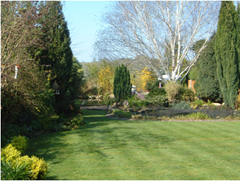 I have recently received an invitation to contribute to this prestigious Website. It is a great pleasure to share my experience and knowledge with our customers and I hope that it will prove beneficial to many.
I have recently received an invitation to contribute to this prestigious Website. It is a great pleasure to share my experience and knowledge with our customers and I hope that it will prove beneficial to many.
However, I must stress that this is only my opinion, though it is based on over 30 years involved in Gardening. Firstly, to give the reader an understanding of my hobby I thought a brief introduction to my own garden and ponds would be of use so that readers and viewers could gauge their own position in relation to mine.
I am the oldest of the Keengardener team and as a result probably have the most practical experience. I have always had a keen interest in Gardening generally and Water Gardening in particular having installed ponds in both of my previous homes.
My family and I live in rural Worcestershire, just a few miles over the border from the Keengardener offices in neighboring Warwickshire. We moved to our present home some 10 years ago and whilst it was purchased primarily for its home and location qualities, the fact that the 200 foot long garden had 2 fully landscaped garden ponds with volumes of 10,000 and 35,000 litres convinced me that this was the location where I would settle and pursue my interest in Gardening and Aquatics.
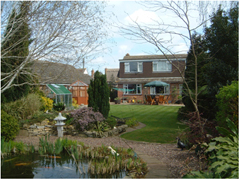 I have included with this introduction a number of recent photographs taken in Spring to illustrate the appearance of the garden and ponds now, however I would mention that its appearance 10 years ago was very different with inadequate pond filtration, no aeration, murky water and lethargic fish.
I have included with this introduction a number of recent photographs taken in Spring to illustrate the appearance of the garden and ponds now, however I would mention that its appearance 10 years ago was very different with inadequate pond filtration, no aeration, murky water and lethargic fish.
Even now I would like to enhance the filtration further but, as always, time and money are my eternal enemies.
The smaller of the 2 ponds is populated with goldfish. Orfe, Shubumkins and 3 small Koi, and they all now enjoy a pampered existence. I have added to their number each year, but only young healthy fish.
I would always advocate that part of the enjoyment of Aquatics is to see young fish grow into mature specimens over a number of years. There is of course a considerable cost saving involved too!!!! The pond volume is some 10,000 litres varying in depth from 6 inches to 3 feet; it has a butyl rubber liner which is in good condition and a filtration system of my own design though I have enhanced this considerably by adding a Hozelock Saturn Booster. The water is fed to the filtration system by a Hozelock Aquaforce 15,000 Filter pump and via a 25w UVC. The water is returned to the pond down two waterfalls which cascade through a raised bank situated at the back of the pond and planted with dwarf conifers, ferns, ornamental grasses and bamboos. This system ensures good water flow and necessary aeration. The Aquaforce 15,000 pump employed for this system is indeed a trusty work horse; it works 24 hours a day, 7 days a week and only rests when I close the ponds down in October/November each year.
My decision to close the ponds down on both my ponds is a personal one, and one which is either supported or frowned upon by Pondkeepers. My reasons for doing this are numerous:-
1) Fish - activity is much reduced and feeding ceases.
2) Time - is available to strip and clean pumps, filters and UVCs
3) UVC - tubes are replaced and ‘O’ ring seals are checked for condition.
4) Waterfalls - are cleaned and repaired if necessary.
5) Plants - are cut back, thinned out and any decaying vegetation is removed.
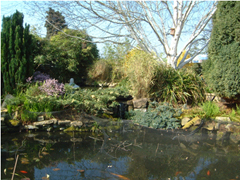 The larger of the ponds is situated behind the goldfish pond and separated by a metre wide stone walkway with both shaded by a beautifully shaped Silver Birch Tree.
The larger of the ponds is situated behind the goldfish pond and separated by a metre wide stone walkway with both shaded by a beautifully shaped Silver Birch Tree.
We have a number of Koi in this pond which we inherited with the house and these too have prospered whilst in our care.
At this juncture I would stress that this is a pond which houses Koi, it is not a purpose built Koi pond which has bottom drains, skimmers Vortex’s and thousands of pounds worth of equipment as is the case with serious Koi enthusiasts.
Having said that I would equally stress that the pond is teaming with fish and plant life and it is singularly the most popular part of our garden. It has a resident Grass Snake named “Sidney” and a vast array of vegetation including Lillies, Bullrushes, Iris and on one side is bordered by a healthy bed of Bamboo which enhances the “oriental” atmosphere. The Filter return is through this Bamboo forest and it is indeed a perfect location to enjoy a lazy sunny afternoon accompanied by a chilled bottle of wine!!!
The filters are again of my own design utilizing brushes, sponge, biomedia and 2 25w UVC’s all fed by a 15000 litre per hour pump. My Winter project has been to construct a new 4 foot by 2 foot filter tank populated by 84 15 inch filter brushes which has been extremely successful.
Both ponds are powered by mains electricity fed by armored cable via independent Switchboxes. The garden low voltage lighting made by Ring is wired through the same switchboxes with the transformers housed in an Armadillo Outdoor Powerbox.
Pond Filtration
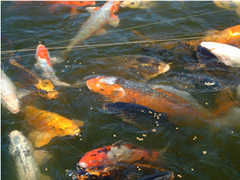 As promised, I am happy to publish my views on the important topic of Garden Pond Filtration as experienced by myself over many years.
As promised, I am happy to publish my views on the important topic of Garden Pond Filtration as experienced by myself over many years.
This topic is probably one of the most varied of all aspects in the Gardeners Water World and different people have their own opinions and systems which they firmly believe is the best.
My opinions are based on 30 years experience of Pondkeeping and in many instances I have learnt the hard way, this has cost me many pounds and I have shed many tears in the process. I am not saying I am right, but, taking into account a reasonable outlay in money and time together with sound advice, the Keen Gardener / Aquarist can enjoy the same success I have experienced and will have the same opportunity to create a water haven in their garden.
If you are about to embark on creating or improving a pond then this advice will, I hope, be useful to you.
All ponds need filtration to ensure a healthy environment for its inhabitants, fish are the most popular addition to any pond and they will only thrive if they are provided with clean water, free from chlorine, ammonia, nitrites, algae, leaves, rotting vegetation etc and the filtration process aims to remove or covert such toxins.
The Equipment needed to achieve this consist mainly of three items, 1) a solids handling pump to ensure a healthy flow of water to 2) A UVC which flocculates microscopic Algae to enable 3) the filter to remove Algae, solid and biological waste from the pond.
The pond pump is at the heart of any system, it must be robust, reliable, efficient and economic. It will have to function continually throughout the year moving high volumes of water to your system and most importantly must have the ability of pumping solids if necessary. I have found the Hozelock Aquaforce Pond Filter Pump range as supplied by Keengardener Ltd to satisfy my personal requirements.
They are available in 6 sizes to suit most pond sizes and the requirement when deciding Pump size must be to circulate the pond’s volume through the filter system once every 2 – 3 hours. So if you have a pond whose Volume is say, 8,000 litres then I would suggest that the Hozelock Aquaforce 4000 Filter Pump is the pump needed to achieve water clarity, though there are other factors to take into account. These are the number of fish in the pond and the amount of sunlight likely to bear down on the pond surface.
The Pump and Filter size will need to be reassessed if you plan to have for instance, 6 large Koi Carp and the Sun is likely to shine on the pond for most of the day. This will put pressure on the Filter to cleanse the water to a satisfactory level given that Koi eat (and therefore excrete) much more than say Goldfish and sunlight encourages the growth of algae (this causes green water in the pond).
The pump will need to transport the polluted water to the next Filtration stage; this is usually to pass the water through a Ultra Violet Clarifier (UVC). I will cover the UV next but finally some further thoughts on pumps. There are many Manufacturers and models available which make a bewildering selection to the novice, my tip is to calculate the size required and choose a model made by a reputable household name carrying a long guarantee.
Hozelock carry a 3 year warranty, although I have received regular comments from satisfied customers who have enjoyed service far exceeding this period. Generally in this product range, the old adage of “you get what you pay for “definitely” applies. At this juncture, I am obliged to comment as to whether many of the cheaper Far Eastern brands will give the same level of reliability. In my humble opinion a cheap or undersized pump is false economy, you will be a disappointed Water Gardener.
An Ultra Violet Clarifier (UVC) is the next part of our system jigsaw and can be a separate item or included as part of the filter unit. If it is separate it is positioned between the pump and filter. They vary in size depending on the volume of water passing to the filter and their purpose is to assist in the elimination of Algae from your pond. Algae consists of microscopic particles which multiply rapidly in the pond, assisted by sunlight and will produce a green soup if not treated.
I must stress that this water does not hurt any wildlife in the pond but it makes it unsightly and difficult to admire your fish. The effect of Ultra-violet light on the Algae is to make it clump together (flocculate) and these larger particles are therefore much easier for the filter medium to retain in the Filter container. The removal of Algae from Pond water ensures clarity and is a vital component in the filter process.
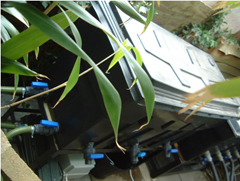 Personally I prefer the stand alone UVC as they tend to be larger, stronger and more efficient. For ease of use and tidiness the all inclusive filter is the preferred option.
Personally I prefer the stand alone UVC as they tend to be larger, stronger and more efficient. For ease of use and tidiness the all inclusive filter is the preferred option.
Given a choice, I would purchase from the Bioforce UVC range. However with some 35000 litres to filter I have had to construct my own filters as stated earlier and even then I need more filter capacity.
As I have already stated, you cannot over-filter your water. The main controlling factors are money, time and space. My stand alone UVC’s are made by TMC which I have found to be reliable effective and long lasting.
Whichever UVC you use please remember that once they have been switched on they will need a constant flow of water passing through them or damage will result from overheating, so, if for any reason you switch off your pump, then, please remember to switch off the UVC too.
The UV bulbs must be changed to maintain effectiveness and I would suggest that this is done each Spring. If like me, you close down your system each Winter then at this time it is advisable to change the bulb, check the ‘O’ ring seals, remove the scale on the glass tube and clean it thoroughly. The same maintenance procedure is recommended for the combined UVC/Filter range.
We now arrive at the business end of our Filtration System, the filter itself, and here we have a huge and bewildering array of Equipment available dependant on the size of your pond, depth of your wallet, space available, personal preference, breed of fish kept, mode of returning the cleansed water back to the pond etc.
In the time available in this text I cannot possibly consider all the equipment available but will enlighten the reader to my system and briefly consider the benefits of the Hozelock range which has been available for many years and is a popular and effective product in the Keen Gardener range.
Firstly filtration is carried out in two ways within a system, these being mechanical and biological. Mechanical Filtration is the process of removing solid matter from the water, be it leaves, algae, surplus fish food, fish waste and other floating debris. Biological Filtration is carried out within the Filter and is the process of converting invisible toxins and waste, largely produced by fish and rotting vegetation, into less harmful substances. This process is achieved by establishing a bed of friendly bacteria within the filter which break down ammonia into nitrite and then nitrite into harmless nitrates. The biological process not only ensures CLEAN water but more importantly HEALTHY water.
This biological process is built up within the filter, initially over a 5 or 6 week period when any new filter commences operation. Neither the friendly bacteria nor the toxins are visible to the naked eye but they are there and it is vital to establish and maintain this process if your pond is to thrive. Filters once established, must be left running 24 hours a day as the friendly bacteria needs a constant flow of oxygenated water to survive. Once this ceases the bacteria bed will start to die so try to keep periodic maintenance breaks short so that your bacteria bed is maintained.
My Filtration system may be considered by many to be a little dated but I have enjoyed continuing success with it and I see no reason at present to replace it, only enhance it. Once the water leaves my twin 25w TMC UVCs it enters my new Brush filter which has now been in operation since this Spring. The Filter box is actually a 4 foot by 2 foot by 2 foot Water tank in which I have suspended some 84, 15 inch brushes. These are placed in rows across the width of the tank and stretch almost the entire length. There is a space of approximately 6 inches at the bottom of the tank where incoming water enters and as the water rises through the brushes they catch the suspended matter before cleansed water exits 4 ports on the top right hand side, down Cypliflex hose to 2 other original filter boxes (I have 3 ball valves situated at the bottom of this new filter for periodic maintenance when the system is stopped and the debris is washed from the brushes and sponges, drained into buckets and used to feed some conifer beds). The water is passed along a series of spray bars and percolates through 4 layers of sponge and a bed of biomedia before exiting the biological phrase of filtration and returning to my pond down a man made waterfall and stream some 4 metres long.
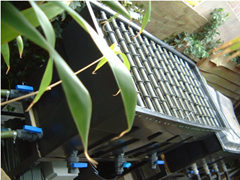 I hope the accompanying photographs illustrate this system adequately. My Goldfish pond has a similar system and I would be the first to acknowledge that there are more intricate systems available, however, I consider that having worked within the usual constraints of time and money, I have created an acceptable environment for my fish. They appear to be healthy and happy and reward me with much activity especially at feeding and spawning time when all hell lets loose!!!
I hope the accompanying photographs illustrate this system adequately. My Goldfish pond has a similar system and I would be the first to acknowledge that there are more intricate systems available, however, I consider that having worked within the usual constraints of time and money, I have created an acceptable environment for my fish. They appear to be healthy and happy and reward me with much activity especially at feeding and spawning time when all hell lets loose!!!
Filter systems for Pondkeepers are of course readily available from numerous sources and the Hozelock range offers solutions to suit many pond and wallet sizes. The Hozelock Ecoclear range is designed along the more traditional lines and can be purchased with or without built in UVC’s, each Filter has a recommended volume classification depending on its size and contents. The Ecoclear rely on gravity to return water to the pond and hence need to be positioned either at the top of a waterfall or directly above the pond surface, they are simple but effective but have lost popularity since the introduction of the Hozelock Bioforce range which has many advantages over its sister Filter.
The new Bioforce UVC Filter range have capacity levels of 3000, 5500, 8000 and 12000 and whilst they still rely on sponges for mechanical filtration, they have the revolutionary Kaldness K3 Biomedia for improved biological filtration, this is achieved with vastly superior surface area for greater capacity compared with other Biomedia. The other major difference is that it is a pressurised filter and as such can be positioned at any point, even buried up to its lid, and will expel cleansed water at the same pressure that it entered the filter cylinder. I would strongly recommend this system for the smaller pond up to 12000 litres. Its easy clean facility is another plus and with a built in UVC, the Pondkeeper has a compact and effective piece of equipment for a fraction under over £100.
For the novice, Hozelock remove the worry regarding the matching of Pump, UVC and Filter by producing matched sets under the name of Hozelock Ecoclear Pond Pump and Filter Combinations and these are, not surprisingly, very popular. Here again, I would recommend this system for simplicity and effectiveness.
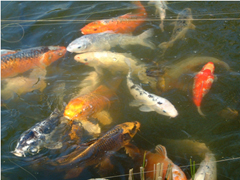 I consider that by following some simple rules the Pondkeeper can soon become proficient at his/her new hobby.
I consider that by following some simple rules the Pondkeeper can soon become proficient at his/her new hobby.
Don’t rush, follow the instructions, use the correct tools for the job, don’t panic, especially with the plumbing and double check the electrical connections.
When establishing a new pond and/or new filter initially turn the UVC off when running the filter as this aids the bacteria in establishing a base within the Filter box. Do not overload the Filter by buying too many fish, certainly not in the first few months, losses will result. Get in the habit of cleaning the Filter Box on a regular basis, washing the sponges in clean pond water that you have collected in a bucket. I mention this as tap water has chlorine in it which destroys the friendly bacteria. I would suggest that you firmly resist the temptation to hose the Pond Filter.
If your system has been set up correctly and been running for say 6 weeks so that the water is aged and mature you can then introduce fish and start to enjoy being one of many thousands of gardeners who do the same, water brings a garden to life and in my humble opinion, no garden is complete without a pond.
End of Season Shutdown
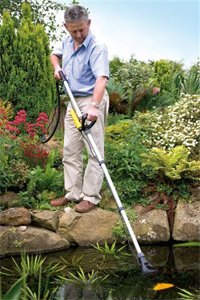 This article covers one of the most important stages in the Pondkeepers year, certainly as far as my own ponds are concerned, and that is the “Season Shutdown.” Before I commence, I am aware that many pondkeepers run their equipment continually and I am not for one minute saying that this practice is incorrect but for me and many others, this is the time to rest the pond and all its inhabitants. I have heard many contrasting views but at a time when temperature is the most important consideration, I consider that the movement of water out of the pond brings a chilling effect and that is contrary to my and my fishes’ requirements.
This article covers one of the most important stages in the Pondkeepers year, certainly as far as my own ponds are concerned, and that is the “Season Shutdown.” Before I commence, I am aware that many pondkeepers run their equipment continually and I am not for one minute saying that this practice is incorrect but for me and many others, this is the time to rest the pond and all its inhabitants. I have heard many contrasting views but at a time when temperature is the most important consideration, I consider that the movement of water out of the pond brings a chilling effect and that is contrary to my and my fishes’ requirements.
This period also allows me to carry out much needed maintenance, cleaning filters, servicing other equipment, cutting back plants and allowing my fish to rest in inclement conditions. All fish slow down considerably through the Winter months and the owner should certainly refrain from feeding, to do so will cause digestive problems which may prove fatal. They will come to no harm fending for themselves until warmer temperatures return. I would then recommend that initially a wheatgerm diet is commenced before moving onto higher protein food.
Autumn time is therefore a time of repair and replenishment and it should be started by ensuring that the Gardener himself is prepared for the tasks ahead by dressing sensibly with old but warm clothes, it is also advisable to arm yourself with some good quality pond gloves such as those made by Stanley Pond Gloves or Briers Pond Gloves. These are available from Keen Gardener and will ensure that you remain clean and healthy when dealing with the mucky elements of Pond Maintenance.
Let’s get started! Firstly switch off all equipment and gently lift the pump, it will no doubt have a good coating of algae and probably have an accumulation of sludge within its cage. It should be washed away and the algae removed; I would suggest using a green plastic kitchen scourer which I find ideal for the task. Then place the pump in a recently mixed solution of Interpet Pond Pump Cleaner which will bring it back to new and dissolve any build up of debris within the pump. Flush the pump out with a hose and then wrap it in horticultural fleece and a plastic bin liner to protect it from the frost. I leave the pump safely beside the pond ready to reinstall it in the Spring. By doing this I do not have to unplug the cable from my switchbox nor dismantle the Cypriflex hose.
Filters are the most demanding chore and the type of filter you have will determine the amount of time needed to complete the job. The Cylindrical Bioforce Filters should be stripped out carefully and everything washed with clean water. At this juncture it is wise to check all sponges, seals and “O” rings for any wear. The seals should be clean and flexible so gently tension them between your forefingers and if you can see any cracks in the rubber, replace with new ones. These seals take a mighty punishment during the year and need to be in tip top condition. I would strongly recommend that one of the appropriate Annual Service Kits are purchased as they contain all the necessary consumables for your filter including a new UVC tube. The tube must be replaced every 12 months to maintain its effectiveness.
The more traditional box filters are treated in much the same way and here again I employ a scourer to remove stubborn debris and renew any damaged sponges and seals. The most demanding task I have is to clean my brush filter which you may recall I manufactured myself a year or so ago. There are a large number of brushes suspended on supporting plastic pipe rods secured to the tank walls. I lift out each row and flush with a hose to remove all the debris. Whilst this is time consuming, it reflects on how good this filter is and once done I can expect it to perform as well next year. Unfortunately Hozelock do not make kits for traditional box filters but it is advisable to carry spares of these items which can be purchased from Hozelock direct.
If you have a standalone UVC then it should be unplugged and taken inside to prevent frost damage. While it is decommissioned, clean the inside thoroughly, change the bulb, wash the protective glass sleeve and inspect for damage. Remember to “flex and inspect” the rubber seals and replace if in doubt.
Finally I wrap the air pump in fleece and a plastic bag after first dismantling the air stone to clean and put inside for next year. It is wise at this stage to inspect the hoses to ensure they are flexible and free from damage. In the event of replacement, use Hozelock Cypriflex hose. I firmly believe that this hose is the most flexible available to the pondkeeper so don’t be tempted by cheaper varieties, these are usually more rigid and will crack after a season or so.
That completes the equipment overall. In my garden it takes a weekend but it is time well spent as I am now primed for Spring.
Needless to say if any equipment is suspect or beyond repair then replacement now is often the best course of action as you can take advantage of End of Season Sales. Special Offers are often available at Keengardener.co.uk so please look regularly.
Unfortunately this equipment review is not the end of the chores, especially if you have deciduous trees in your vicinity. Throughout Autumn, leaves are a constant nuisance to the pondkeeper. They are not only unsightly, but can also cause water quality problems if allowed to accumulate in the pond. Fortunately Keen Gardener stocks a number of items to assist you in your battle for a healthy clean pond...
The first in the armory may in fact already be in place if you have been troubled by herons and that is a pond net. Whilst small leaves will escape the mesh, larger ones are retained and can be removed. The pond nets, made by Interpet, are available in a large array of sizes and come complete with fixing pegs. There are two colours, black or clear, and although initially they are quite noticeable, one soon learns to look through them. It is certainly preferable to having a pond full of leaves or, worse still, a satisfied heron! As for the leaves which have penetrated the net, you are best advised to arm yourself with a pond net and extract them whilst they are still afloat. Leaves will usually sink within 24 hours of landing on water and they are very difficult to net once this happens.
May I now introduce you to the Wolf Pond Net and Wolf Telescopic Handles for this task. I specifically recommend these as the net is both robust and flexible and is just the right size to get in all those nooks and crannies. The handle extends from 117cm to 200cm, is made from aluminium for lightness and longevity and, again will assist in reaching difficult spots. There is no reason why this handle and net pairing will not last for many years which will justify the expense, as these German made tools are not cheap. As I have already mentioned, get in the habit of leaf fishing on a regular basis as they are easily caught if still on the surface.
My final comments revolve around equipment that can be used all year but best suited to small to medium size ponds, and one of those is the Hozelock pond vac. There used to be 2 main types; the Hozelock CypriVac which is a hand operated device (which has now been discontinued), suitable really for only small ponds, and its powered and more effective brother, the Pond Vac. My own ponds are too big to consider using these tools but Keen Gardener has many customers who have both these types and swear by them. This is compact and light, consumes just 80 watts and has 4 x 0.4 metre sections to make it versatile and of course less effort to operate. A session hoovering the pond floor with a vac will always benefit the pond at Autumn time, though its operational limits are often exceeded when considering the large pond.
This completes my own Task List, though I am conscious that there may be more depending on your own set up. However, the Winter frosts will soon be upon us and any extended cold spell will cause the pond to freeze over. There a number of additional basic rules to consider and I make no apology for emphasizing them.
1) Refrain from banging the ice as this sends shock waves through the water which will stress the fish.
2) Keep children and pets off the ice for obvious reasons, I recall the occasion 2 or 3 years ago when my own Miniature Schnauzer was tempted to try out his Torvill and Dean Dance routine. The ice gave way and he was left isolated some 6 feet from the bank. Fortunately my sister is law was in the vicinity and she quickly kicked off her shoes and walked into the icy depths to rescue him. He was indeed a grateful Schnauzer!
3) Place one or two under inflated plastic footballs in the water before the frosts arrive and they will keep a small area free from ice, allowing bad air to escape.
4) If you are willing to buy a pond heater and pay for the running costs then this will supercede the above. They are available from specialist shops and are quite effective but I would argue that they are excessive for the usual short usage period.
That concludes my comments on this important aspect of Water Gardening. I do hope that I have convinced you to carry out this work diligently and suggest that you contact Keen Gardener whom will only be too pleased to assist you with any queries you may have.
Hozelock Airpumps - An Essential Accessory?
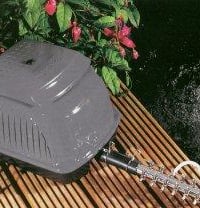 The Pond Air Pump is an item of Aquatic Equipment often overlooked by the Pond Keeper who prefers to concentrate on Filters, Pumps and visual attractions. In this small composition however, I hope to convince the reader that the Air Pump too offers real benefits to the Pond and its inhabitants.
The Pond Air Pump is an item of Aquatic Equipment often overlooked by the Pond Keeper who prefers to concentrate on Filters, Pumps and visual attractions. In this small composition however, I hope to convince the reader that the Air Pump too offers real benefits to the Pond and its inhabitants.
Generally, most Air Pumps are made of similar construction, being an aluminium cage containing a mains electric motor and finished with a sturdy, substantial and weatherproof outer cover. They are usually mounted on rubber feet to minimize noise and transmit the air down tubing, usually to a 12 outlet metal manifold. These outlets have small ON/OFF taps to control the flow and I have in the past used these to power 12 blue airstones. Whilst these airstones are modestly priced, their life is usually restricted to one season. Instead now I use a ceramic air disc approximately 8 inches diameter, these can be purchased from more specialized Koi stores and usually cost £20 or so. The advantage of these is that they last many years and also produce a large plume of fine bubbles when in operation and thus are far superior to the standard stones.
Hozelock manufacture 2 sizes of Air Pump, a Hozelock Air Pump 45LPH and the Hozelock Air Pump 75LPH delivering 45 litres per minute and 75 litres maximum. The output is of course affected by the depth of operation and at a typical 1 metre depth, output is 35 litres and 45 litres respectively. The maximum operating depth is 2 metres and 3 metres which exceeds the depth of most garden ponds.
“So,” I here you say, “what can this do for me?” Well, may I first state that it is not an absolute necessity to have this facility, but once you install it, you will notice that your fish, particularly Koi and Orfe, are visibly more active. Fish adore swimming through the tower of bubbles produced by the air diffuser and additionally they benefit from increased oxygen levels which normally decrease in hot sunny weather. Whilst this increased oxygen replenishment will allow for higher stock levels, it is wise to consider the capacity of your filter or losses may occur.
Non-pressurised filters such as the Trinamic or any of the traditional box filters can also benefit from the Air Pump simply by running one of the air lines from an outlet and into the biological section of the Filter, add an airstone and away you go! This will encourage and assist bacterial activity and thus make filtration more efficient.
I usually only run my Air Pump through the Summer but it also has a use in the Winter as the moving water it produces does not freeze and therefore allows for any poisonous gases to escape and oxygen can be absorbed into the pond. The operating cost of this Pump is modest as it consumes just 35 watts (half a standard light bulb) so it can be justified within the majority of household budgets.
The best way of installing the Air Pump is through a switchbox such as those made by Blagdon or the marvelous Armadillo Switch Box made by Greenbrook, this way you have instant control. My Air Pump is now approaching its 15th birthday, that’s what I call value for money!
There is my case for this little workhorse, as far as I can see there are no disadvantages. It is reliable and hardworking but most importantly your fish will thank you time and time again by being more active healthy and entertaining. Go on, treat yourself and your fish!
The Hozelock Saturn Booster Review
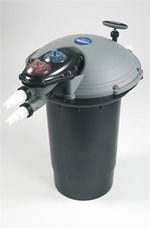 One of the benefits of my involvement with this feature on ponds is that occasionally, I am asked to test the performance of new products and this latest composition revolves around the Hozelock Saturn Booster which was released in early 2008. Throughout this year I have been operating this mechanical pre-filter on the smaller of my 2 ponds and wish to share with you my experiences. This filter is claimed to be suitable for ponds up to 30000 litres which I think is a little ambitious, certainly if you have a healthy population of fish. My pond capacity of 10000 litres was however well within its capability and its claim of 75% debris removal was to be well tested with the results, as you will read, being most satisfactory.
One of the benefits of my involvement with this feature on ponds is that occasionally, I am asked to test the performance of new products and this latest composition revolves around the Hozelock Saturn Booster which was released in early 2008. Throughout this year I have been operating this mechanical pre-filter on the smaller of my 2 ponds and wish to share with you my experiences. This filter is claimed to be suitable for ponds up to 30000 litres which I think is a little ambitious, certainly if you have a healthy population of fish. My pond capacity of 10000 litres was however well within its capability and its claim of 75% debris removal was to be well tested with the results, as you will read, being most satisfactory.
On unpacking the Booster I was immediately impressed by its presentation and build quality, the packing is solid and well thought out, protecting its precious contents on all sides. The plastic body and fitments are manufactured with excellent quality materials being predominately grey/black plastic. This material is of course necessary as the Booster is a sealed and pressurised Filter and must therefore expel clean water to the UVC and biological Filter at the same rate as is taken from your pump. The only pre installation work necessary was to affix the inlet valve assembly onto the body, this was easily completed as the instruction sheets are comprehensive and the required tooling well catered for.
On installation, there are a number of basic rules to follow if trouble free operation is to be achieved. Firstly a flow rate of between 3000 and 8000 litres per hour is needed, so ensure your pump will deliver this requirement. The Booster must be positioned first in the filtration cycle, directly after the pump, and before the UVC and biological filter. When siting the pump, lift it some 6-9 inches off the pond floor so as not to ingest excessive sediment. This is best done by laying it safely on some clean wall bricks.
The Booster itself should be sited on a flat level surface which can be above or below the pond water level. The 4 hoses can then be connected; these should be of the same diameter, personally, I would suggest either 32mm or 40mm so that the required volume of water is transferred with ease.
The filter bypass hose is situated beside the inlet hose and must lead back to the pond. This hose is utilized in the event of high pressure within the filter when a valve automatically redirects the water back to the pond. This arrangement protects the filter in the unlikely event of a problem and it is satisfying to know of its existence.
The outlet and flush-away hoses should again match the inlet hose for size and should not rise more than 1 metre above the Booster. My outlet hose leads to my UVC and biological filters and is 1 1/2 metres in length and at the same height. The flush-away hose is just 45cm long and as it is positioned above the surrounding area I can easily flush away dirty water and debris into a bucket before disposing onto my shrub borders.
Once I had finished installation, I double checked both hose and electrical connections to ensure correctness and switched on the pond pump. It takes a while for the water to fill the whole filter system, but once water is flowing through you may activate the Booster. The only noise is a slight humming as the electric pump inside backwashes the mesh filter removing solid waste that will settle on the bottom of the vessel. Finally switch on the UVC and recheck all joints for water tightness, and the valves for correct positioning.
The Hozelock Saturn Booster should now operate continuously through the Season as did mine, with maintenance carried out weekly as follows. Please, please get into the habit of activating the flush-away at least once every week for a period of at least 15 seconds. It takes me approximately half that time to fill my waste bucket so I operate the handle and continue to do so until the water passing through to the bucket is clear. This indicates that all the sludge waste stored in the vessel bottom has been expelled.
At this juncture I must emphasize that I was staggered to see how much sediment and waste my Booster had extracted. This of course has a major impact in reducing the amount of debris being passed to the biological filters and hence dramatically reduces the maintenance requirements of those filters. In fact, I seem to recall that I had to operate the sludge taps on my biological filters just twice throughout the season, this being a vast improvement on my pre Booster seasons.
Hozelock provide a detailed instruction booklet with the Saturn Booster which includes a copious amount of fault-finding tips. I have to admit that I did not have to refer to this in my first season, which is proof of the operating qualities of this filter and also the importance of regular maintenance. At the height of the Summer I found that I was extracting some 4 buckets of filthy water each week and it is wise to note that when operating the flush handle, a continuous opening and closing of the flush-away mechanism will dislodge stubborn settlements of sludge which otherwise may remain inside.
You will not be surprised to hear that I am a big fan of this pond Pre-Filter and would recommend it to all Pondkeepers who can accommodate it within their filter system, which should be pump fed and non pressurized. I personally support the claims made by the manufacturers, of cleaner water and reduced maintenance for existing filters. I am looking forward to next season when I will once more put the Saturn Booster through the Filtration Test.
